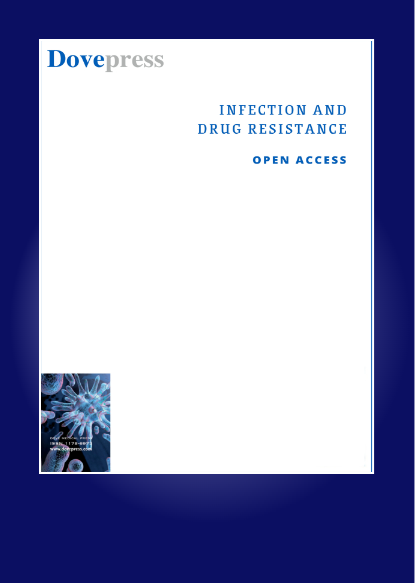中国苏州未接种疫苗人群中肺炎链球菌的血清型和基因型
IF 2.9
3区 医学
Q2 INFECTIOUS DISEASES
引用次数: 0
摘要
背景:肺炎链球菌是一种重要的感染病原体,通常与其他潜在致病菌一起栖息于人类鼻咽部。本研究从社区人群中获得了肺炎链球菌菌株,并对其表型、基因型和疫苗覆盖率进行了调查:方法:从光福社区健康人群的鼻咽拭子样本中分离出肺炎双球菌。方法:从广福社区健康人群的鼻咽拭子样本中分离出肺炎双球菌,分别采用Quellung反应和多焦点序列分型(MLST)鉴定菌盖血清型和基因型。采用最小抑菌浓度检测抗菌药敏感性:结果:共对 500 名未接种疫苗者进行了采样。共鉴定出 94 株肺炎双球菌。常见血清型为 19F、6A 和 9V。PCV13 和 PPV23 的菌株覆盖率分别为 61.7% 和 58.5%。约 27.6% 的分离株对青霉素无耐药性,超过 80% 的分离株对红霉素和强力霉素有耐药性。在所有菌株中发现的 27 种新型序列类型(ST)中,最常见的 ST 类型是 ST236(6/94,6.4%)和 ST12669(6/94,6.4%)。近一半的菌株被分为四个克隆复合体(CC12665、CC271、CC6011 和 CC180),其中 CC271 对 PEN 的耐药性最高:结论:在我们的研究中,在健康人群、老年人和儿童中发现了肺炎链球菌的各种耐药克隆复合体。因此,肺炎球菌疫苗应纳入国家免疫计划,以防止疾病传播。本文章由计算机程序翻译,如有差异,请以英文原文为准。
Serotypes and Genotypes of Streptococcus pneumoniae in an Unvaccinated Population in Suzhou, China
Background: Streptococcus pneumoniae is a significant etiological agent of infection and commonly inhabits the human nasopharynx, alongside other potentially pathogenic bacteria. In this study, S. pneumoniae strains were obtained from a community population and subjected to investigation of their phenotypes, genotypes, and vaccine coverage.
Methods: S. pneumoniae was isolated from nasopharyngeal swab samples of a healthy population in the Guangfu Community. Capsular serotypes and genotypes were identified using Quellung reaction and multilocus sequence typing (MLST), respectively. The antimicrobial susceptibility was tested using minimum inhibitory concentrations.
Results: In total, 500 unvaccinated people were sampled. Ninety-four S. pneumoniae strains were identified. Common serotypes were 19F, 6A, and 9V. The strain coverages of PCV13 and PPV23 were 61.7% and 58.5%, respectively. About 27.6% isolates were non-susceptible to penicillin, and over 80% were resistant to erythromycin and doxycycline. Among 27 novel sequence types (STs) identified in all strains, the most common STs were ST236 (6/94, 6.4%) and ST12669 (6/94, 6.4%). Nearly half of the strains were grouped into four clone complexes (CC12665, CC271, CC6011, and CC180), of which CC271 showed the highest resistance to PEN.
Conclusion: In our study, various drug-resistant clone complexes of Streptococcus pneumoniae were found in the healthy population, the elderly, and children. Consequently, pneumococcal vaccines should be included in the national immunization schedule to prevent disease spread.
Methods: S. pneumoniae was isolated from nasopharyngeal swab samples of a healthy population in the Guangfu Community. Capsular serotypes and genotypes were identified using Quellung reaction and multilocus sequence typing (MLST), respectively. The antimicrobial susceptibility was tested using minimum inhibitory concentrations.
Results: In total, 500 unvaccinated people were sampled. Ninety-four S. pneumoniae strains were identified. Common serotypes were 19F, 6A, and 9V. The strain coverages of PCV13 and PPV23 were 61.7% and 58.5%, respectively. About 27.6% isolates were non-susceptible to penicillin, and over 80% were resistant to erythromycin and doxycycline. Among 27 novel sequence types (STs) identified in all strains, the most common STs were ST236 (6/94, 6.4%) and ST12669 (6/94, 6.4%). Nearly half of the strains were grouped into four clone complexes (CC12665, CC271, CC6011, and CC180), of which CC271 showed the highest resistance to PEN.
Conclusion: In our study, various drug-resistant clone complexes of Streptococcus pneumoniae were found in the healthy population, the elderly, and children. Consequently, pneumococcal vaccines should be included in the national immunization schedule to prevent disease spread.
求助全文
通过发布文献求助,成功后即可免费获取论文全文。
去求助
来源期刊

Infection and Drug Resistance
Medicine-Pharmacology (medical)
CiteScore
5.60
自引率
7.70%
发文量
826
审稿时长
16 weeks
期刊介绍:
About Journal
Editors
Peer Reviewers
Articles
Article Publishing Charges
Aims and Scope
Call For Papers
ISSN: 1178-6973
Editor-in-Chief: Professor Suresh Antony
An international, peer-reviewed, open access journal that focuses on the optimal treatment of infection (bacterial, fungal and viral) and the development and institution of preventative strategies to minimize the development and spread of resistance.
 求助内容:
求助内容: 应助结果提醒方式:
应助结果提醒方式:


